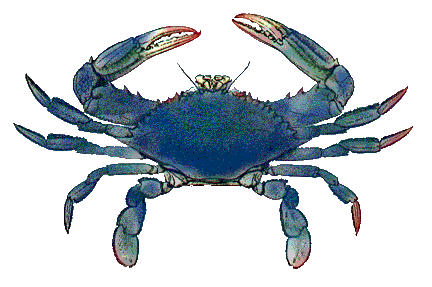

 |
 |
| The blue crab is one of the most common
marine invertebrates in the western Atlantic. The common range of
the blue crab is from New England to Florida. Periodic appearances
of the blue crab have also been noted in parts of Europe, most likely due
to transportation of the species in ships ballast. The blue crab
may be found in salt, fresh and brackish waters, but is most prevalent
in the latter. The blue crab may grow up to eight inches lengthwise
across the shell. Coloring of the crab is blue, blue-green or brown
with cream colored markings on top. The bottom of the crab is white
with red markings. Once cooked, the crab takes on a scarlet hue.
To some people blue crabs are as much a part of a summer vacation as sun bathing. The blue crab is one of the most common estuarine invertebrates from the Mid-Atlantic to the Gulf of Mexico and supports a tremenduous commercial fishery and a large recreational fishery as well. Commercially crabs are caught either in pots or with trot lines in the warm months when they are active or with dredges during the winter. Crab pots are generally made of wire and, baited with pieces of fresh fish, set in likely spots. The floats that crab fishermen use to locate their pots can be seen dotting our bays in the warmer months of the year. Trotlines are long lines that have regularly spaced baited dropper lines hung from them at intervals. The fisherman runs along the line with his boat, gently lifting the line and netting the crabs that are hanging onto the bait. Blue crab is prepared either in the hardshell or softshell forms. Hardshell crabs are commonly boiled whole, and served still within their shells. The hard shell is cracked be hand or with the aid of nut crackers. Once the shell has been broken into, nearly the entirety of the crab meat may be consumed.. The meat within the body of the crab is thick and whitish in color, while pieces from the legs are smaller and flakier. Meat from the two large claws is solid and more abundant than meat found in the smaller legs. Softshell crabs are prepared in a different manner, this preparation begun right after the crabs are caught. Softshell crabs are those that have just newly molted. Crabbers will inspect their freshly caught crabs to determine which are about to molt. Those that are about ready are separated from the rest of the crabs and held in shallow tanks supplied with running water until they molt. These crabs are more valuable on the market than hardshell crabs, and after being cooked the entire crab, shell and all, may be consumed. In the Mid-Atlantic, blue crabs spawn from May until October. The female crab carries millions of eggs in order to compensate for larval high mortality rates. After hatching, the crabs mature quickly, reaching full size within twelve to eighteen months. Crab "shedding" is a rapidly developing industry that lies somewhere
between commercial harvesting and aquaculture. By inspecting the freshly
harvested crabs, a fisherman can determine which are within a few days
of molting. These pre-molt crabs are segregated and held in shallow tanks
supplied with running water until they shed their old shells. The newly
molted crabs are called soft-shells and are worth significantly more than
their hard-shelled siblings.
|